Lead Tokens
Lead tokens appear to have been used in Britain from the late-13th cent to the early-mid 19th. The former period is the one during which fractional denominations were first introduced, rather than using pennies alone and chopping into halves and quarters, whilst the latter is the period during which the Government first successfully overcame the shortage of small change which had plagued the country for several centuries. This may or may not be coincidence.
Even the smallest official coin, the farthing, was a significant portion of a man’s weekly wage, and hence practicality drove communities to resolve a situation which the authorities were not able to. No official record survives of who struck them where, what they were valued at or under what local agreement they circulated; they probably had a very limited geographic radius of use and were probably struck or cast by some such craftsman as the local blacksmith. Not all crude lead will have been coin, however; some of them were almost certainly passes, whilst others will have had their value defined in terms of commodities or services rather than the currency of the day.
The earliest pieces, c.1275-1500, tended to be pewter rather than pure lead and were almost certainly of ecclesiastical origin; it is known, for example, that some bear the initial letters of church service names on them, whilst others were clearly for use by the travelling pilgrims whom they depict. Perhaps these pieces were deployed at the hostelries en route to Canterbury. Many, but not all, of these early pieces are very small; sometimes as little as 11mm.
More Ornate Pewter Pieces
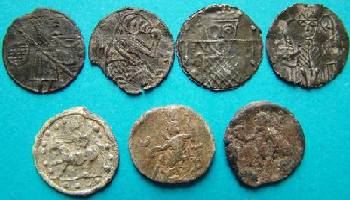
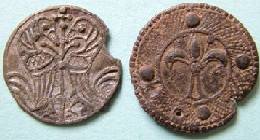
Later pieces are usually pure lead, typically increasing to about 15-17mm in the Civil War period and often up to around 25mm in the 18th century. I say typically; there is no standard of manufacture to which anybody was obliged to conform, and it is the consequent diversity which gives the series its attraction. Precise dating of pieces is difficult; only about 7-8% of them bear dates, and these are nearly all in the period 1690-1810. The earliest I know of is 1512 and the latest 1848, but occurrences before the Civil War are exceptionally rare. There are few also after 1820, and such examples as I know come from Co.Durham, on the coast near Tyneside.
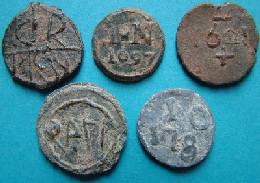
Geographically there is a strong predominance of finds to the eastern side of the country, with Romney Marsh and East Anglia being the two most productive areas. The hop farms of Kent and East Sussex are known to have used white metal pieces until very late in the 19th century, and it may well be that some anonymous crude lead precedes the other, more identifiable, pieces of the later period. There is also a small but lesser hop community on the Surrey/Hants border, for which crude lead is known. Other pockets include Durham, Nottinghamshire, the Bucks/Herts/Oxon border, West Sussex and, of course, London; there will be others, but west of this line crude lead tends to be, whilst not unknown, comparatively scarce.
London is a world of its own, and the single feature by which London lead pieces are usually identified is the very dark colour of the metal; provincial material is usually quite light. This may be due to some extent to the environment in which the pieces are buried; many London pieces are recovered from the Thames.
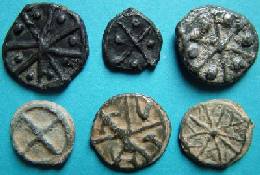
There is little identification on crude lead to offer much hope to the genealogist or historian; no placename, a couple of initials occasionally, and often not that. The designs are various. A few appear repeatedly, such as the flower of six petals, the cartwheel, the lis and the anchor; these are thought to be stock designs of semi-obscure ecclesiastical origin, but then who knows whether the anchor represents the anchor of salvation, maritime commerce, or simply a pub of that name?
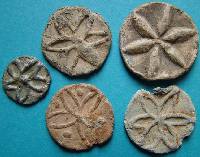
The cross and pellets is frequent, and presumably derives from the coinage of the first three Edwards; as also certain designs which appear to resemble a miller’s threshing stone, which may hint at their usage.
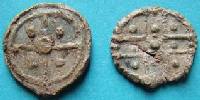
Very common, and usually presumed to be 18th century, are pieces which just have meaningless linear doodles; perhaps the ordinary man’s way of distinguishing pieces which, if issued by minor gentry, would bear a coat of arms. The latter do occur occasionally, but are never very detailed; perhaps they indicate either usage on a country estate, or that the issuer was a merchant and member of a commercial guild.
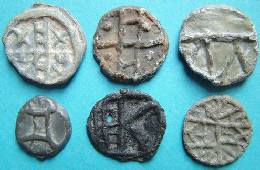
Instruments of trade, or merchant’s marks, are found in small quantities; ditto drinking utensils, presumably indicating tavern tokens, and birds, animals and trees of various descriptions. Depictions of loyalty, in the shape of crowns, roses and the like, are not uncommon, but are usually associated with the Elizabethan period.
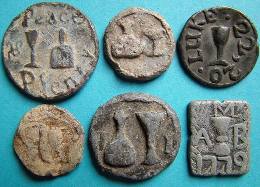
The Romans used crude lead for similar reasons to ourselves, and pieces are found at Roman centres in England, e.g. Colchester. They have a different distribution of subject matter from the more modern material, but are essentially the same in concept; for example, people, wildlife and plantlife are all depicted much more frequently, whilst the specifics of Roman culture replace those of the English. Generically known as tesserae, the crude lead from around Rome itself is based on the quadrans, their ancient equivalent of our farthing, and is often very small; whilst by contrast, Roman material found in Britain is often chunkier.
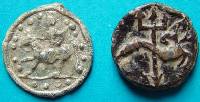
Other nations have had similar local issues, but because lead pieces generally have been little regarded or studied in any country not much is known about them; indeed, even historians and collectors have often considered them beneath their consideration, and in consequence many pieces have been lost. Their frequent poor condition and almost invariable anonymity puts many people off, but they can be attractive, they were part of our history, and it is good that, with the advent of ever more powerful metal detectors, interesting pieces are being found which might hitherto have escaped detection.
David Powell
September 2006
